
There are a myriad of air compressor types, technologies, and configurations out there, and at times, it can be very overwhelming! Michaels has written many articles on various aspects of compressed air systems and controls (check out the News Briefs archive here and here), however, this particular Brief goes back to the basics of compressed air by identifying and describing the most common types of compressors.
Reciprocating
A reciprocating compressor is what most people will think of if asked about an air compressor. These are the small compressors many people can find in their garages, or for sale at the local home improvement store. These compressors work just like a car engine, by moving a piston up and down. As the piston moves down, it draws air into the cylinder. When the piston moves up, it compresses the air and pushes it out the valves at the top. Reciprocating compressors work great for small intermittent loads, but will usually require a tank because of large pressure swings. A reciprocating compressor will modulate flow by turning on and off, and are typically less than 100 HP in size.
Screw
Screw compressors, as the name implies, compress air by spinning two screws together inside a stationary housing. As the screws rotate, the flowing air is squeezed into smaller and smaller spaces until the high pressure air is discharged into the compressed air piping.
Screw compressors are the most common compressors found in industrial settings and work great for continuous operation. They can have a variety of control types for controlling airflow, and if controlled with a variable speed drive, can be very efficient over swings in airflows. These compressors typically range from 100 HP all the way up 500 HP.
Centrifugal
Centrifugal compressors are the big boys of the compressor world. An impeller rotates thousands of times per minute, pulling air in through the middle, and spinning it rapidly to the outside of the housing. The air, which is now moving extremely fast, is then forced into a tiny opening which slows the air speed and increases the pressure. These compressors, like most pumps, are therefore also referred to as “dynamic” compressors. Centrifugal compressors operate very efficiently at, or near, full load, but have very poor performance when not fully loaded. Many of these will not be able to unload below about 70% of the maximum airflow and just blow whatever isn’t needed in the room. Centrifugal compressors also tend to be the largest; most are larger than 250 HP, with some getting up to more than 2,000 HP! This makes them a staple in medium and large industrial facilities where compressed air is used continuously.
Each of these compressor types operate differently from the others and have different strengths and weaknesses. More detail will be provided on these in future Briefs.




